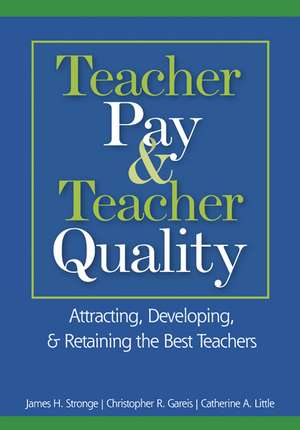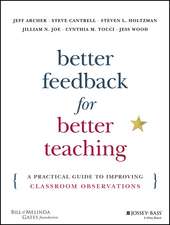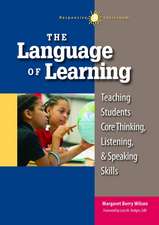Teacher Pay and Teacher Quality: Attracting, Developing, and Retaining the Best Teachers
Autor James H. Stronge, Christopher R. Gareis, Catherine A. Littleen Limba Engleză Paperback – 22 mai 2006
`The authors have amassed a tremendous amount of information and assembled it into a very readable book that is an excellent resource.'
-Randel Beaver, Superintendent, Archer City School District, TX
Attract and retain the highest-quality teachers through competitive compensation programs!
While many working in the teaching profession cite intangible rewards as reasons for staying in the profession, concrete rewards such as salary, benefits, and working conditions are inextricably linked to recruiting, motivating, and retaining highly-qualified teachers. This timely text examines the fundamental link between teacher pay and teacher quality as well as the extent to which it is aligned with student achievement.
Existing compensation models are reviewed in order to provide a practical, research-based approach for developing a comprehensive, best-practice teacher compensation system. School administrators can use these synthesized, innovative findings to:
Determine the most practical compensation model for achieving their school's objectives
Examine different pay options used across the country
Connect their school's compensation program to organizational goals
Discover how to attract and retain high-quality teachers
| Toate formatele și edițiile | Preț | Express |
|---|---|---|
| Paperback (1) | 283.38 lei 6-8 săpt. | |
| SAGE Publications – 22 mai 2006 | 283.38 lei 6-8 săpt. | |
| Hardback (1) | 515.72 lei 6-8 săpt. | |
| SAGE Publications – 22 mai 2006 | 515.72 lei 6-8 săpt. |
Preț: 283.38 lei
Nou
Puncte Express: 425
Preț estimativ în valută:
54.23€ • 56.88$ • 45.14£
54.23€ • 56.88$ • 45.14£
Carte tipărită la comandă
Livrare economică 01-15 aprilie
Preluare comenzi: 021 569.72.76
Specificații
ISBN-13: 9781412913218
ISBN-10: 1412913217
Pagini: 200
Dimensiuni: 178 x 254 x 13 mm
Greutate: 0.43 kg
Ediția:1
Editura: SAGE Publications
Colecția Corwin
Locul publicării:Thousand Oaks, United States
ISBN-10: 1412913217
Pagini: 200
Dimensiuni: 178 x 254 x 13 mm
Greutate: 0.43 kg
Ediția:1
Editura: SAGE Publications
Colecția Corwin
Locul publicării:Thousand Oaks, United States
Recenzii
"The authors have amassed a tremendous amount of information and assembled it into a very readable book that will be an excellent resource."
"This is a good and needed book. I would buy it, and recommend it to a wide range of educators."
"Makes several noteworthy contributions to current deliberations about how teacher compensation systems might promote the recruitment, retention, and ongoing development of a high-quality teacher workforce."
"This is a good and needed book. I would buy it, and recommend it to a wide range of educators."
"Makes several noteworthy contributions to current deliberations about how teacher compensation systems might promote the recruitment, retention, and ongoing development of a high-quality teacher workforce."
Cuprins
Acknowledgments
Preface
About the Authors
1. Attracting, Developing, Retaining – and Paying – Quality Teachers
Examining Motivation: Do Financial Incentives Work in Promoting Teacher Quality?
How We Pay Teachers: A Brief History of Teacher Compensation
Current Issues and Trends in Teacher Compensation
Teacher Pay and Teacher Quality
Concluding Thoughts: Where Do We Go From Here?
2. Teacher Pay and School Purposes: How Do They Relate?
Aligning Teacher Compensation With Organizational Purpose and Direction
Moving Forward: Key Considerations for Developing a Compensation System
Establishing Criteria: Defining and Measuring Quality
Summary: Teacher Compensation in the Big Picture of School Purpose
3. Competitive Salaries and Benefits: How Do We Stack Up?
How Do Principles of Environmental Scanning Apply to Teacher Compensation Systems?
How Can the Competitiveness of Teacher Salaries Be Assessed?
How Can Nonsalary Benefits Contribute to a Competitive Salary Package?
What Role Can Working Conditions Play in a Competing Market?
Summary: Teacher Quality and Competitive Pay
4. Considering Options for Teacher Pay: What Are the Promising Possibilities?
Single-Salary Schedule
Extra Duty/Additional Responsibility Pay
Career Ladder
Knowledge- and Skills-Based Pay
Individual Evaluation Pay
Performance-Based Pay
Creative Compensation: Other Ways of Recognizing Teacher Quality
Summary
5. Building a Model Teacher Compensation System: What Will Work Best for Us?
Assumptions About Compensation Systems
Design Principles: Considerations in Teacher Compensation
Designing a Compensation System Aimed at Quality
A Component-Parts Approach to Teacher Compensation
A Model for Teacher Compensation
A Closer Look at the Components of Compensation
Compensation and Quality
Alternatives to Consider
Concluding Thoughts: Designing a Compensation System
6. From Planning to Implementation: How Do We Make This Change?
Step 1: Develop the Aims and Criteria of the Compensation System
Step 2: Select Compensation Components
Step 3: Plan for Implementation
Step 4: Pilot the Restructured Compensation System
Step 5: Districtwide Implementation and Evaluation
Concluding Thoughts: Teacher Quality and Teacher Pay
Endnotes
References
Index
Preface
About the Authors
1. Attracting, Developing, Retaining – and Paying – Quality Teachers
Examining Motivation: Do Financial Incentives Work in Promoting Teacher Quality?
How We Pay Teachers: A Brief History of Teacher Compensation
Current Issues and Trends in Teacher Compensation
Teacher Pay and Teacher Quality
Concluding Thoughts: Where Do We Go From Here?
2. Teacher Pay and School Purposes: How Do They Relate?
Aligning Teacher Compensation With Organizational Purpose and Direction
Moving Forward: Key Considerations for Developing a Compensation System
Establishing Criteria: Defining and Measuring Quality
Summary: Teacher Compensation in the Big Picture of School Purpose
3. Competitive Salaries and Benefits: How Do We Stack Up?
How Do Principles of Environmental Scanning Apply to Teacher Compensation Systems?
How Can the Competitiveness of Teacher Salaries Be Assessed?
How Can Nonsalary Benefits Contribute to a Competitive Salary Package?
What Role Can Working Conditions Play in a Competing Market?
Summary: Teacher Quality and Competitive Pay
4. Considering Options for Teacher Pay: What Are the Promising Possibilities?
Single-Salary Schedule
Extra Duty/Additional Responsibility Pay
Career Ladder
Knowledge- and Skills-Based Pay
Individual Evaluation Pay
Performance-Based Pay
Creative Compensation: Other Ways of Recognizing Teacher Quality
Summary
5. Building a Model Teacher Compensation System: What Will Work Best for Us?
Assumptions About Compensation Systems
Design Principles: Considerations in Teacher Compensation
Designing a Compensation System Aimed at Quality
A Component-Parts Approach to Teacher Compensation
A Model for Teacher Compensation
A Closer Look at the Components of Compensation
Compensation and Quality
Alternatives to Consider
Concluding Thoughts: Designing a Compensation System
6. From Planning to Implementation: How Do We Make This Change?
Step 1: Develop the Aims and Criteria of the Compensation System
Step 2: Select Compensation Components
Step 3: Plan for Implementation
Step 4: Pilot the Restructured Compensation System
Step 5: Districtwide Implementation and Evaluation
Concluding Thoughts: Teacher Quality and Teacher Pay
Endnotes
References
Index
Notă biografică
James H. Stronge is the Heritage Professor in the Educational Policy, Planning, and Leadership Area at the College of William and Mary, Williamsburg, Virginia. His research interests include policy and practice related to teacher quality, and teacher and administrator evaluation. He has worked with numerous school districts and other educational organizations to design and implement evaluation systems for teachers, administrators, and support personnel. His work on effective teachers focuses on how to identify effective teachers and how to enhance teacher effectiveness. Dr. Stronge has presented his research at conferences such as American Educational Research Association and Association for Supervision and Curriculum Development, conducted workshops for national and state organizations, and worked with local school districts.
He has been a teacher, counselor, and district-level administrator. His doctorate is in the area of educational administration and planning from the University of Alabama.
Descriere
This review of existing teacher compensation models provides school administrators with a research-based approach for developing a compensation system that attracts and retains high-quality teachers.











